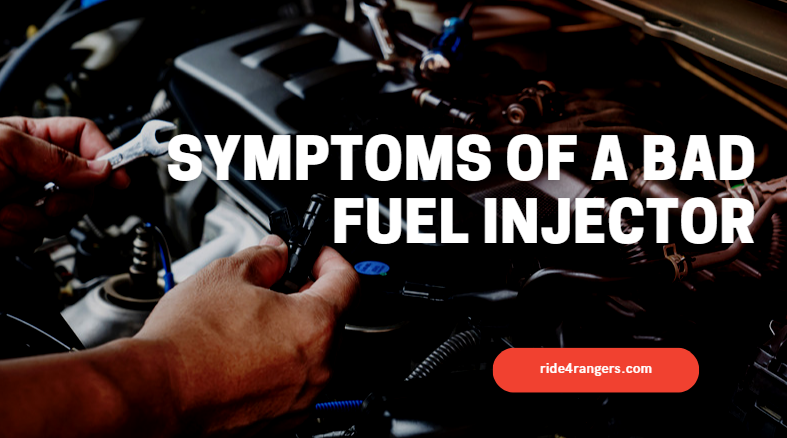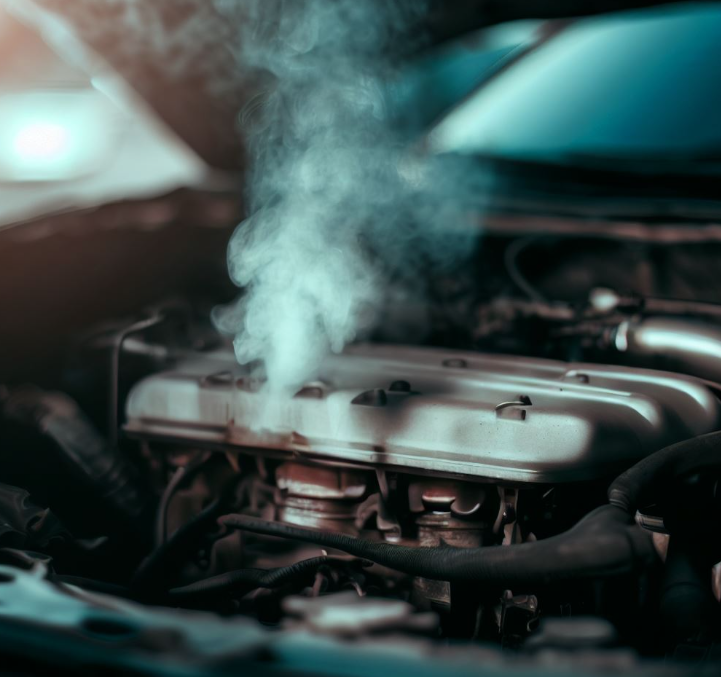Fuel injectors are pivotal gears in the modern engine’s machinery. Think of them as the heartbeats of your car, pulsing fuel into the combustion chamber. With the guidance of the engine’s brain (the computer), they ensure your ride runs smoothly.
But like all machinery, they aren’t immune to wear and tear. Over time, they can become clogged or even faulty, causing your vehicle to act out.
In this guide, we’ll dive deep into the signs that tell you your fuel injector might be throwing a tantrum and, importantly, what you can do about it.
Symptoms of A Bad Fuel Injector

1. The Looming Check Engine Light
The sudden illumination of the check engine light on your dashboard is akin to your vehicle whispering a secret concern to you. But what is it trying to say? More often than not, when related to the fuel system, it’s pointing towards the fuel injector.
The engine’s computer, an unsung sentinel, continually monitors all vehicle components. When it identifies an irregularity with the fuel injector, it reacts by lighting up this warning.
Digging deeper into this issue requires technology. Utilize an OBD2 scanner, and you’ll decode these warnings, uncovering specific issues tied to codes like P0200 or P0300. It’s the engine’s way of narrating a story, signaling to you that the fuel injectors need attention.
2. Misfiring: The Engine’s Distress Call
The sudden jerk, the unexpected hesitation – these signs are the engine’s equivalent of a distress call. This phenomenon, known as a misfire, is the result of the cylinders not firing correctly, usually because of inconsistent fuel delivery. It’s alarming, causing the engine to lose power or, at times, release a loud, distinctive pop from the exhaust.
If this symptom resonates with your experience, consider diving deeper into the causes of engine misfires. It’s essential to address these promptly as prolonged misfiring can lead to bigger issues, such as damage to the catalytic converter.

3. The Ever-Thinning Wallet: Poor Fuel Economy
Imagine cruising down familiar routes, enjoying your favorite songs, the engine humming its gentle rhythm, and then realization dawns – you’re visiting the gas station way too frequently. It’s like that unwanted rendezvous you never asked for. This frequent ‘gas stop’ scenario, while heavy on your pocket, is an echo of deeper issues with your vehicle.
At the heart of this problem often lies a compromised fuel injector. It’s astounding how this tiny component can make such a dent in your wallet. When the injector is clogged or faltering, it’s like a kink in a garden hose – disrupting the smooth flow. Such a hiccup either starves your engine or floods it. Both are problematic. An engine starved of fuel labors more, guzzling more gas, while an engine flooded with fuel simply wastes it, burning inefficiently.
Addressing this doesn’t just make economic sense, but it’s a step towards being environmentally responsible. An inefficient engine isn’t just burning a hole in your pocket, but it’s releasing more emissions, contributing negatively to the environment. Thus, nurturing a healthy fuel injector is both a personal and planetary boon.
4. Restless Resting: The Rough Engine Idle
Close your eyes and imagine the gentle heartbeat of your resting engine – a rhythmic, predictable sound. Now, shatter that image with an engine that sounds like it’s had one too many coffees. Instead of a peaceful lull, it grumbles, stutters, and even throws in a shake or two. This isn’t some car tantrum but a genuine cry for help.
When the engine idles, it should be the epitome of mechanical peace. But a restless engine often points to issues with fuel delivery. It’s like feeding a baby – too much or too little, and there’s a ruckus. In this case, the ruckus is due to the fuel injector not dispensing fuel consistently. A disrupted flow can play havoc with the engine’s combustion process, making it feel like a rocky boat in a storm when it should feel like a calm lake.
Listening to your engine, understanding its highs and lows, its content purrs and distressed cries, is crucial. It’s speaking to you, signaling when all’s well and when there’s a hiccup in its rhythm.
5. A Nose Knows: The Odor of Fuel
The nose knows, they say, and nowhere is it truer than when diagnosing car troubles. If there’s a distinct scent of gasoline, it’s more than just an assault on your olfactory senses; it’s a red flag. The aroma, sharp and unmistakable, often spells trouble in the form of leaky fuel injectors.
These leaks aren’t mere nuisances; they’re like ticking time bombs. Fuel seeping from injector nozzles or seals isn’t just wasteful; it’s dangerous. Think about it – fuel, a highly combustible substance, leaking near hot engine components? It’s a recipe for potential disaster.
Apart from the imminent fire risks, there’s the issue of wasted fuel and increased emissions. Every drop counts, both for the environment and your pocket. Hence, if your nose catches a whiff of gasoline, don’t brush it off. Investigate. Address. Ensure safety.
6. Lethargic Movements: The Struggle of Poor Performance
When the energy and zest usually felt in your car’s acceleration suddenly turns to a sluggish, hesitant effort, you might be witnessing the symptoms of a faulty fuel injector. Whether due to being clogged, dirty, or faulty, an imperfect injector can lead to a substantial loss of power, making scenarios like overtaking on highways or climbing uphill roads feel like Herculean tasks. On the flip side, if it’s leaky or constantly open, you’re likely to see a drop in efficiency. Remember the last time you stepped on the pedal, and your car didn’t shoot forward with its usual enthusiasm? That’s a tangible symptom right there. If these symptoms sound all too familiar, perhaps you should also read about why a car may lose power during acceleration here.
7. That Unsettling Sound: Engine Knocking
We’ve all been there: a momentary pause in the music or conversation inside the car, and you hear that unwelcome knocking or pinging sound. Engine knocking isn’t just an auditory annoyance; it’s an indication of detonation within the cylinder, a potentially damaging process.
Factors like a clogged injector that leads to a too-hot and too-rapid burn or a leaky injector resulting in leftover unburned fuel can both cause these unsettling sounds.
It’s essential to address this early on, or you might be in for expensive repairs involving pistons or cylinder walls.
8. Clean Air, Failed Test: The Emissions Issue
We all want to do our bit for the environment. But if your vehicle fails its emissions test, it could be hinting at a bad fuel injector being the culprit. When injectors are dirty or clogged, they might cause an incomplete burn, releasing harmful nitrogen oxides (NOx) into the atmosphere.
Meanwhile, a leaky injector might lead to excessive burning, letting out carbon monoxide (CO) and hydrocarbons (HC). It’s not just about passing tests; it’s about keeping our air clean.
For those puzzled by irregular readings on their mass airflow sensor, considering its role in maintaining proper air-fuel mixtures, you might want to check this out.
9. Cranking Up: The Hard Starting Dilemma
Picture this: a chilly morning, you’re getting late, and your car refuses to start promptly. Hard starting can be more than just an inconvenience; it’s often a sign of fuel injectors either denying the right amount of fuel due to being clogged or flooding the cylinder due to leakage.
These conditions can make your morning routines a test of patience. Especially if you’ve noticed the engine taking its sweet time to roar to life or demanding the starter fluid.
If idling issues accompany these symptoms, the idle air control valve might also be involved. Dive deeper into its symptoms here.
10. Listen Closely: Decoding Fuel Injector Noises
Cars communicate. Sometimes, it’s through the gentle hum of a well-tuned engine, and at other times, through stark, irregular noises.
A fuel injector isn’t silent; its natural state is a faint click. But if you’ve started hearing more pronounced sounds – be it a whistle, buzz, or knock, your injector could be hinting at problems. While an occasional strange sound might get dismissed, consistent unfamiliar sounds should catch your attention.
11. A Halted Journey: Engine Stalling
Every driver’s nightmare: cruising on a road and suddenly, the engine stalls. When injectors are not in their prime, they can disrupt the harmony of your ride.
A clogged injector can often make the engine give up during idling or at lower speeds.
In contrast, a leaky injector can betray you during those exhilarating high-speed runs. It’s not just about the annoyance; sudden stalling can be dangerous. Regular checks can save you from unexpected halts.
Restoring Your Fuel Injector: A Guide for Every Car Lover
We’ve all had those moments where our beloved vehicle starts showing signs of weariness. One of the culprits can be the fuel injector.
But before diving into heavy repairs or replacements, there are a few remedies worth trying.
The Magic Elixir: Fuel Injector Cleaner
Have you tried using a fuel injector cleaner? This isn’t just any additive; it’s like a detox drink for your car. By breaking down the unwelcome deposits clogging up the injector, it often rejuvenates its performance. Just remember, for the best outcome, always stick to the instructions on the bottle. Think of it as following a recipe – precision can make all the difference.
The Breath of Fresh Air: Compressed Air
Sometimes, the simplest solutions can be surprisingly effective. Using compressed air can help dislodge any debris or blockages in your injector. But, when giving your injector this quick puff, always ensure you’re wearing the right safety gear. It’s a bit like giving your car a gusty pep talk.
The Diagnostic Tool: Ohmmeter
When was the last time you felt off but didn’t know why? Your injector has those moments too. With an ohmmeter, you can check its well-being. By measuring resistance and comparing those readings to your vehicle’s manual, you can pinpoint any discrepancies. It’s a tad technical, but sometimes you need to speak the car’s language.
Lighting the Way: Noid Light
If the ohmmeter feels like reading a book, the noid light is watching the movie. This tool will visually alert you if the injector is receiving power. When you see it blink rapidly as you crank the engine, you know there’s life in there. If not, well, it might be time for some professional advice.
Feeling the Pressure: Fuel Pressure Gauge
Your car’s heartbeat can be felt through the fuel pressure. Using a fuel pressure gauge, you can check if the fuel flows with the right gusto. If something feels amiss, especially when comparing it with your vehicle’s specs, there might be an underlying leak or blockage. For more insights on this, it’s worth checking out an article about when a car vibrates at a red light. Sometimes, issues are interconnected, and one can lead you to the root cause of another.
Conclusion
Cars, like us, have their good days and bad ones. The key is to listen, understand, and act. Your fuel injector might just need a bit of care and attention.
So, before making any hasty decisions, try these remedies. They might just save you a trip to the mechanic. Safe driving!
Tim Hayden is a seasoned car mechanic and expert with a wealth of experience in the automotive industry.
With a deep passion for cars and a knack for solving complex mechanical issues, Tim is dedicated to providing valuable insights and practical tips to car owners.
Trust his expertise to keep your vehicle running smoothly.